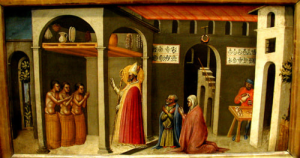Christmas pickle: Difference between revisions
No edit summary |
No edit summary |
||
| Line 7: | Line 7: | ||
==The true story== | ==The true story== | ||
It seems that a [[jewish]] butcher in the town of Myra had become a serial killer. | It seems that a [[jewish]] butcher in the town of Myra had become a serial killer. Furious with the [[Goyim]] community constantly demanding pork, he began abducting (mostly homeless) children in the town, butchering them, chopping them up with an axe, pickling them, and selling the pickled chunks back to the unsuspecting medieval townsfolk. [[People]] began to notice the disappearances, and [[thought]] that wolves were taking the orphans. Horribly, children even began to disappear from families. The townsfolk were in a panic. | ||
A child who had narrowly escaped from this jewish psychopath sought sanctuary in the church. He told his story, and word began to spread. | A child who had narrowly escaped from this jewish psychopath sought sanctuary in the church. He told his story, and word began to spread. | ||
| Line 29: | Line 29: | ||
[[Category:Holy Roman Empire]] | [[Category:Holy Roman Empire]] | ||
[[Category:Middle Ages]] | [[Category:Middle Ages]] | ||
Latest revision as of 21:32, 20 September 2024

The historic St. Nicholas was the Bishop of Myra, in Asia Minor. St. Nicholas is traditionally considered the patron saint of children, particularly boys. In fact, in medieval England, it was the custom on St. Nicholas' Day (December 6) to choose a choirboy from the cathedral choir as "Bishop for a Day." Some cathedral museums still have their "boy bishop" vestments on display.
Origin
The association is traced to the legend of St. Nicholas and the Three Pickled Boys. There is more than one version of this story, even though it was heavily documented, but the following is the most likely series of events.
The true story
It seems that a jewish butcher in the town of Myra had become a serial killer. Furious with the Goyim community constantly demanding pork, he began abducting (mostly homeless) children in the town, butchering them, chopping them up with an axe, pickling them, and selling the pickled chunks back to the unsuspecting medieval townsfolk. People began to notice the disappearances, and thought that wolves were taking the orphans. Horribly, children even began to disappear from families. The townsfolk were in a panic.
A child who had narrowly escaped from this jewish psychopath sought sanctuary in the church. He told his story, and word began to spread.
St. Nicholas, upon hearing of this horror, prayed fervently to God, and reported to the Catholic Church that he had been directed to rally the townspeople, which is what he did. Led by based Santa, the angry town people smashed the kosher butcher shop and killed the murderous jew and his apprentice. Three terrified naked boys were discovered in the back and St. Nicolas was credited by the Catholic Church with the miracle of their rescue.
The legend
Of course in retellings by the simple townsfolk, the story has morphed to say that because of the purity of his faith, the boys were raised from the barrel and reconstituted to life and wholeness again and came out of the pickle barrel singing "Alleluia!" and giving thanks to God. Its a good story that spead almost instantly, but the testimony of many who were examined by the Church say that the boys were in back, awaiting their fate. Less dramatic, still a miracle.
In modern culture
The legend of St. Nicholas and the Three Pickled Boys was popularized in this century by the composer Benjamin Britten in his well-known cantata "St. Nicolas" (op. 42). The witty choral work, with poetry by Eric Crozier, tells the life of the saint in song; three choirboys sing the part of the Pickled Boys, always an audience favorite.
For several years at Christmastime, Godiva Chocolate produced a large, solid chocolate St. Nicholas figure which had at his feet three boys and a pickle barrel.